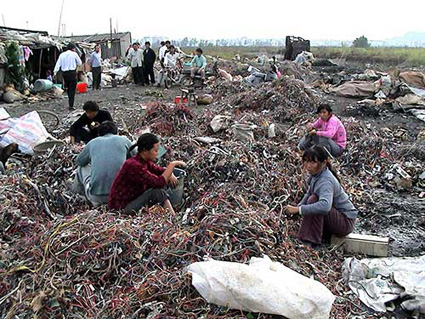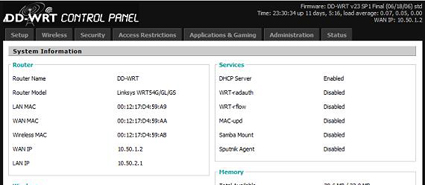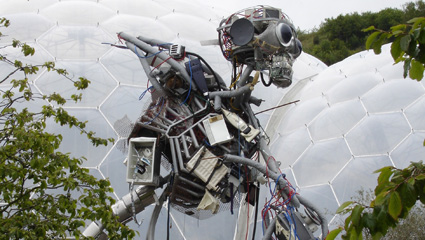Introduction
By now we’ve all heard of the damage that carbon emissions can do to the environment. Al Gore’s warnings about global climate change and its discontents, the Intergovernmental Panel on Climate Change, and even a planned climate change concert all weave together to get our attention about the growing problem. But the inconvenient truth of the matter is that there’s more to pollution than carbon emissions.
Let’s do a thought experiment. Chances are you’re reading this on a computer. Or if you aren’t, there’s probably a computer somewhere in your life. Now think about that computer and everything connected to it. Network cables, keyboards, mice, printers, routers, switches, toasters, space stations. Everything. And think about all of the electronics, computer components, and random gadgets you’ve gone through in your lifetime. Now bring all that together in a big pile somewhere in your mind. Impressive, isn’t it?
And that’s just your pile. There are billions of similar piles being built up every second all over the world by people just like you, all consisting of discarded electronics, or ‘e-waste’.

Women picking through old computer wires in Guiyu, China.
Photo © Basel Action Network 2006.
Now it’s time for the scary statistics part. More than 4.6 million tons of this kind of waste turned up in landfills in the United States in 2000, according to the Environmental Protection Agency. In a lifetime, the average UK citizen produces over 3.6 tons of e-waste. E-waste also accounts for 70% of the United States’ toxic waste, while pound-for-pound making up only 2% of its total landfill waste.
And where does all of this waste end up? According to the Basel Action Network – a non-profit organization that aims to reduce the international trade of toxic waste – it gets exported to countries like China, India, and Pakistan where it is burned, melted, dumped into the river, and otherwise mishandled.
This Sunday is Earth Day. So why not pitch in and do something simple that will make an impact on the environment around you? This guide will give you an overview of how you can make a difference in the tide of e-waste, starting with your very own network.
What is Being Done
Governments worldwide are in the process of drafting and enacting legislation to reduce the amount of e-waste. The European Union passed a pair of bills in 2002 to help with the problem of European e-waste. The Waste Electrical and Electronic Equipment (WEEE) and the Reduction of Hazardous Substances (RoHS) directives charge manufacturers of electronic equipment with the task of helping users recycle these products and reducing the amount of hazardous materials such as lead and mercury contained within them.
The US Congress is also considering House Resolution 425—also known as the National Computer Recycling Act—to implement infrastructure and policy changes to help with the recycling of old computers. And state-specific bills are making an appearance in the US every day. But as is ever the case with governmental happenings, these changes will take time to have an effect.
In the meantime, companies like Dell and HP are taking steps to curb e-waste with programs to help users recycle their old computer hardware. But while they may be one of the biggest and most visible producers, e-waste does not stop with computers. In this age of information, a single disconnected computer is worth nothing. An oft-overlooked aspect of e-waste is the very tubes that make the Internet work: networking products. Routers, switches, hubs, cables, and more are thrown away every day.
While HP and Dell both offer e-waste takeback programs (Dell even offers a snazzy Flash overview of their asset recovery services here), only HP’s recycling program accepts networking products. The first piece of network equipment costs $30 before shipping, with each additional piece costing $26. The program can be found here and is available worldwide, though as of this writing does not cover countries in Africa or Latin America. While HP is to be applauded for accepting more than computers, the costs of its program are out of line with the <$100 cost of most consumer networking gear.
Networking companies themselves have also taken notice of this problem, particularly in places that force them to do so by law such as the E.U., and have begun to take action. Netgear, D-Link, and Linksys all comply with the European WEEE and RoHS Directives. Some have even gone a step further to introduce power-saving features into their devices to lessen the amount of energy e-waste.
D-Link has started re-engineering their products to reduce power consumption through measures such as automatically powering down fans and hard drives in NAS devices during periods of inactivity. Additionally, given that many North American custom computer builders add Netgear products to their machines – which are in turn exported to Europe – Netgear has opted to go one step further and make all of their products worldwide RoHS and WEEE compliant.
However, the common thread in the recycling and hazardous materials actions of networking companies is compliance. Their efforts are all well and good in Europe and other countries, where directives like WEEE and RoHS place requirements on manufacturers that must be met in order for their products to be sold.
But networking companies do not seem to be as gung-ho about environmental efforts in the United States. Netgear and D-Link are the only companies to have applied RoHS guidelines to products sold outside of the European Union. And recycling efforts undertaken by networking companies are almost unheard of outside of those run by third-parties.
The exception to the lack of recycling efforts comes with Cisco’s takeback and recycle program. The parent company of Linksys, Cisco allows individuals or companies in the US, EU, and South Africa to repackage any Cisco-branded hardware and have it picked up at Cisco’s expense. This program is part of Cisco’s larger Surplus Product Utilization and Reclamation (SPUR) program. SPUR brings together several different waste management programs to help reduce the amount of total waste from Cisco products that finds its way into landfills every year. More information on these efforts can be found on Cisco’s SPUR website.
So while it could be worse—some electronics companies actively oppose producer responsibility in the US while supporting it in Europe (where they are bound to do so by law)—the situation could be much better. Add to that the grinding gears of the legislative process and frustration doubles. But it doesn’t have to. Here are a few steps to help you rethink, reduce, reuse, and recycle that pile of e-waste today, and beat both business and government to the punch.
What You Can Do
Rethink
- Think before you buy that flashy new technology. Gartner, Inc. estimates that companies will waste over $100 billion on unneeded networking technologies over the next five years. Does everybody at your small business really need snazzy gigabit Ethernet to the desktop? Rethinking your gadget consumption is the best way to cut down on both the electronic and financial types of waste.
- At the same time, take into account the future of your network. When building your network, think about where it will be in five years and plan accordingly. Buying some flashy technologies now may save you the trouble of upgrading to them later when they become a necessity, but you can also get away with buying some older technologies (or even reusing some of your old equipment).
- Avoid the siren song of early-adoption. While it may give you bragging rights among your peers and co-workers, that bluster can quickly turn to fluster once the technology is betamaxed and eclipsed by a less-advanced but better-supported rival.
- Keep up-to-date with the latest developments in sustainable technology and green waste disposal. Environmental stewardship isn’t just for hippies anymore. The Treehugger blog is a good resource for environmental news and information and tips on how to make every part of your life greener, while myGreenElectronics hosts a regularly-updated list of environmentally friendly electronic products and manufacturers.
- Speak up! Don’t expect companies to adopt greener practices on their own. It took government regulation to give us things like seat belts, emission standards, and the weekend. Green networking and electronics are no different. As always, the dollar is your most powerful weapon in these situations, and you can use it to your advantage by purchasing networking gear and other electronics from companies who you agree with. You can also make yourself heard by writing to companies that you do buy from and asking them when they are going to have product take-back programs.
- Finding green companies is not always easy to do, as business practices change frequently. But there are a few tools available to help you track the environmental practices of electronics companies. The aforementioned myGreenElectronics lists responsible electronics producers by type, and Greenpeace publishes a periodic guide to green electronics. Neither guide explicitly covers the networking industry, but several of the manufacturers that the guides cover also produce networking products.
Reduce
- Investigate different sources of energy to power your network. A recent study by the Lawrence Berkley National Laboratory found that servers in the United States consumed more power than the entire state of Mississippi in 2005. You can help reduce the amount of power your servers and network consume by investing in Renewable Energy Certificates (RECs) from a company such as 3 Phases Energy. Each of these certificates represent one Megawatt Hour of renewable energy generated and delivered to your power grid, enabling you and others in your area to use less power from coal and natural gas sources and more from renewable sources such as solar, wind, and biomass.
- Do a dry run before crimping your own network cables. This will not only save you a lot of frustration (since we all have suffered the indignity of a poorly-crimped cable at some point or another), but will also cut down on the amount of unusable cable bits that end up in the garbage can.
- Pay attention to the types of materials in the equipment you buy, and whether or not the vendors comply with local laws on the inclusion of hazardous substances. Reducing your intake of these types of substances will also reduce your output once it comes time to finally recycle your equipment. The Electronic Product Environmental Assessment Tool can help you find sensible computers, notebooks, and monitors, and will likely expand to cover networking products and other electronics in the not-too-distant future.

Renewable Energy Certificates are an easy way to invest in sustainable energy
What You Can Do – more
Reuse
- Buy Used – You don’t always have to buy the newest and greatest pieces of hardware to make your net, uh, work – sometimes a used piece of hardware will work just as well. Be on the lookout for factory-refurbished routers, switches, NASes, and other components. Or even put your Craigslist searching abilities to use and pick up pre-loved equipment.
- Sell or donate – Similarly, just because you don’t need that old router or wireless access point doesn’t mean someone else won’t want it. The same rules for getting used equipment apply to disposing of that equipment. You can send them back to the retailer to be refurbished and resold. You can sell it on eBay or Craigslist. You can donate it to a deserving local school or non-profit organization. Or you can even donate it to a computing museum if it’s old enough (or keep it in storage until it is).
When donating or selling your old equipment, however, be sure you don’t also reuse your old information. Wipe all hard drives, clear all stored passwords and encryption keys, empty all non-volatile RAM (but be sure to replace any factory firmware for the benefit of the recipient), and make sure no trace of your presence is left behind.
- Repurpose – Even if you can’t find a new home for your old gear, you can still put it to work on your network in a different role. Try installing a distribution of Linux on your old router and using it as a firewall, intrusion detection system, or even a web server with DD-WRT or OpenWRT. Re-crimp your old network cables to make crossover cables for use between computers. Disable an old router’s DHCP server and use it as a switch.
- In case of emergency – Keep old networking equipment in a good storage closet so you can use it later when your network expands. Networking equipment is fairly resistant against the cycle of obsoletion that plagues its computer counterparts, and so it will still be useful several years down the line when you want to put in that new segment. And don’t rule out the possibility that your new equipment will succumb to the mercy of power surges, natural disasters, or simple failure – old equipment can prove vital to uptime in the face of the unpredictable.

Release and renew the lifespan of your router with DD-WRT
Recycle
- Dispose responsibly – If you must get rid of your old equipment, don’t throw it into the trash! There are many e-waste disposal specialists out there who are more than happy (for a fee) to take the waste off your hands. While it might pain you to spend money to get rid of a product, you can console yourself with the thought that you’re doing the right thing for the environment.
However, many of these specialists just send the waste to other countries to be processed, instead of dealing with the problems themselves. Who can you trust? The Basel Action Network maintains a list of responsible recyclers who have pledged to prevent waste they handle from being transferred to third-party centers (such as developing countries, prisons, or landfills) to be ‘recycled’.
- Many communities have toxic waste collection days a few times a year when you can bring your e-waste to be responsibly recycled for little or no cost. Keep an eye on your local newspaper or check with your local government.
- Take advantage of retailers’ recycling programs – While take-back programs for networking gear are hard to find, more common e-waste is easier to get rid of responsibly:
Best Buy has free drop-off kiosks in each store for cell phones, rechargeable batteries and ink-jet printer cartridges. It also runs recyling events around the U.S., which, unfortunately, don’t list networking gear as acceptable products.
Radio Shack also has free recycling for cell phones and batteries.
Take advantage of Staples’ Recycle for Education program or visit Office Depot to recycle ink and toner cartridges.
- E.U. citizens can put hardware manufacturers to work for them, with the advent of the WEEE Directive. To comply with the directive, manufacturers such as D-Link, Netgear, and Linksys all offer product take-back schemes and other recycling initiatives to help users get rid of their old equipment. The schemes vary from country to country, so contact your device manufacturer for more information on what kinds of local recycling options are available.
Conclusion

The WEEE Man is made up of over 3.6 tons of e-waste such as TVs, computers, washers and dryers.
For more information, you can check out the website.
The truth may be inconvenient, but the solution is easier than you may think. Think of it as just another step in planning out your purchase: check reviews, check environmental impacts, check prices, and buy.
By taking a few moments to think about some of the ways in which you can take a bite out of e-waste. And by educating yourself on the political, economic, and environmental problems and solutions associated with e-waste, you can take the lead on solving this problem.
In the words of 90’s children’s television icon Captain Planet: “The power is yours!”
Happy Earth Day!
